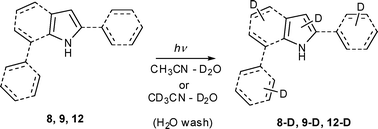Photochemical deuterium exchange in phenyl-substituted pyrroles and indoles in CD3CN–D2O†
Abstract
A new mechanism of photochemical deuteration of some phenylpyrroles and indoles is reported. Irradiation of

* Corresponding authors
a
Department of Organic Chemistry and Biochemistry, Ruđer Bošković Institute, Bijenička cesta 54, Zagreb, Croatia
E-mail:
nbasaric@irb.hr
Fax: +385 1 4680-195
Tel: +385 1 4561-141
b
Department of Chemistry, Box 3065, University of Victoria, Victoria, British Columbia, Canada
E-mail:
pwan@uvic.ca
Fax: +1 (250) 721-7147
Tel: +1 (250) 721-8976
A new mechanism of photochemical deuteration of some phenylpyrroles and indoles is reported. Irradiation of

 Please wait while we load your content...
Something went wrong. Try again?
Please wait while we load your content...
Something went wrong. Try again?
N. Basarić, A. Franco-Cea, M. Alešković, K. Mlinarić-Majerski and P. Wan, Photochem. Photobiol. Sci., 2010, 9, 779 DOI: 10.1039/B9PP00206E
To request permission to reproduce material from this article, please go to the Copyright Clearance Center request page.
If you are an author contributing to an RSC publication, you do not need to request permission provided correct acknowledgement is given.
If you are the author of this article, you do not need to request permission to reproduce figures and diagrams provided correct acknowledgement is given. If you want to reproduce the whole article in a third-party publication (excluding your thesis/dissertation for which permission is not required) please go to the Copyright Clearance Center request page.
Read more about how to correctly acknowledge RSC content.
 Fetching data from CrossRef.
Fetching data from CrossRef.
This may take some time to load.
Loading related content
